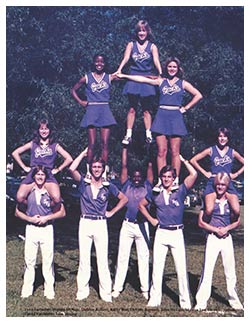Prestigious NYC museum appoints alum as administrator over employee culture
Story by Christine Broussard '10 & '20

Ty Woodfolk '81 is a helper.
He's many other things, of course, like a doer, forward-thinker, organizer, actor (in his spare time), and former pre-dental student (don't tell me your career aspirations haven't drastically shifted before). But his heart is in helping — he just can't help it.
Generations of Lumberjacks have been helped by the part Woodfolk played in creating SFA's iconic "axe 'em" hand sign. He also built a career in compassion, working initially in personnel management and human resources before bridging those talents in recent years to enter the culture and access world.
Woodfolk's successes in this realm have been swift and apparent. His first trek into employee access and belonging was at the Chicago Shakespeare Theater, where he was director of HR. His efforts stood out so much that he was soon after poached by an organization whose name holds prestigious weight (drum roll, please) — the Solomon R. Guggenheim Museum in New York City.
Since being named the Guggenheim's inaugural chief culture and inclusion officer in 2021, he still has moments of disbelief.
"Every time I hear that title now, I have to pinch myself," Woodfolk said over a video call in early January, seated in his Guggenheim office with a shelved wall full of cleanly organized bits and bobs behind him. "This is my ultimate job. From the first day I started here, it's almost like something released. I thought, 'Okay, you're here. You did what you wanted to accomplish.'"
Some of the first steps of his journey into employee culture and access began on the SFA campus, where he started honing his desire to build a life helping others.
Cheer, There and Everywhere

Photo courtesy of the Stone Fort yearbook, 1980
Hold up either hand in front of your face and bend your pinky and ring finger.
Ancient histories of this hand symbol tell of multiple meanings — the hand forms the shape of an axe handle and blade; the crook of the thumb forms either an "L" or "J," depending on its positioning (for "Lumberjacks," of course); and, if we can briefly suspend reality and pretend the hand looks like Texas, the tip of the pinky points to Nacogdoches.
OK, so the symbol isn't ancient — it's only been around for less than half of the university's existence. But it's become an enduring symbol for Lumberjack pride, and Woodfolk served as head cheerleader on the squad that created it.
"That's one of the things I'm probably most proud of, is knowing that, through the sign, we had input in so much of what you see at the university," he said. "It still gives me chills we were able to do that."
Decades later, it continues to represent the enduring spirit of the SFA Lumberjack.
"In my 18 years with SFA's Cheer and Dance Teams, our hand sign remains the one thing that unites all Lumberjacks from the beginning of their time at SFA," said T.J. Maple, coordinator of SFA's Cheer and Dance Teams. "Everyone who attends SFA knows — whether you're in an airport, shopping out of town or pretty much anywhere — if you run into an alum, you can almost guarantee to be greeted with an 'axe 'em' and the hand sign."
Woodfolk graduated from Clear Creek High School in League City, where he was the only male cheerleader and was named an All-American cheerleader. After touring multiple universities, SFA won him over with its pine-filled charm.
So much of Woodfolk's helping-shaped heart was impacted by his time at SFA — by both good and not so good memories.
"Limited opportunities for involvement were probably the part of SFA that I didn't like. Of course, this was 40 years ago, when there were a lot of racial issues, in East Texas particularly," Woodfolk said candidly. "It was just a hard time to be a Black student at SFA. But, you know, that experience led me to the work I'm doing now. I have a lot of empathy because I went through that."
At SFA, Woodfolk initially toyed with joining a pre-dental program then opted to major in theatre. After his "parents kind of talked [him] out of that," he laughed, Woodfolk became drawn to personnel management because it let him tap into his helper-driven nature. He graduated from SFA in 1981 with a Bachelor of Business Administration.
The Big Leagues
The world of human resources wasn't all Woodfolk was hoping it might be.
"When I first started, it was a lot of dealing with policies and procedures,"he said. " I started in Dallas working for a utility company that had a great human resources program. That really built my résumé, but I've always had a desire to concentrate more on helping employees than enforcing policies."
Leaving the energy sector, Woodfolk merged his love of the arts with his goal to position others to succeed and was hired as HR director for the Houston Ballet Foundation. He then moved on to the Chicago Shakespeare Theater, where he could test out his ideas for centering employee access across the spectrum of operations. Continue
"That's why I got the opportunity to work at the Guggenheim — I guess the word got around about my work in workplace inclusion, and I finally made it to New York, to the big leagues."
Woodfolk also more deeply entered the culture and access world during a time of immense cultural change. Months after taking the job in Chicago, the global COVID-19 pandemic forced an overhaul of the traditional workplace; and soon after, the death of George Floyd in May 2020 spurred a global call for racial justice that changed the world — and led most companies to investigate their own cultural shortcomings.
Then Guggenheim hired Woodfolk in August 2021, putting him in a position to help the foundation reckon with its past and lead efforts to help shape its future.
"Like so many others, the Guggenheim had to really determine its fundamental role within the arts industry from a cultural standpoint, not only in terms of taking care of their employees, but also in addressing a long history of collecting predominantly European art," Woodfolk said. "The Guggenheim made a conscious shift to change the culture of the organization, both for their employees and for the art they collect and protect."
In his role as the Guggenheim's inaugural chief culture and inclusion officer, Woodfolk works with museum leadership to "foster an environment that supports the institution's commitment to … [inclusion] principles and values," according to the Guggenheim website.
"In this position, you're improving professional development opportunities for every individual, regardless of whether they're frontline workers or executives," Woodfolk said.
Despite the inroads made in prioritizing equal access in the workplace, he still believes it takes time. And in the meantime, he'll keep growing his role as a leader at one of the most prestigious fine arts institutions in the world.
"Turning the culture is like turning a big ocean liner very slowly," Woodfolk said. "But 10 or 20 years from now, I can look back and say, 'I really had input in changing the culture of the Guggenheim.' And that's an amazing thought.
"I've grown so much — my career has taught me the importance of listening to employees, understanding them, supporting them. And Stephen F. Austin started that flame for me, and I can proudly say that."
Primary image caption:
The Solomon R. Guggenheim Museum's towering silhouette is well known the world over for its unique design. Created by renowned architect Frank Lloyd Wright, the building opened in 1959. Photo by David Heald © Solomon R. Guggenheim Foundation, New York

 Axe ’Em, Jacks!
Axe ’Em, Jacks!


